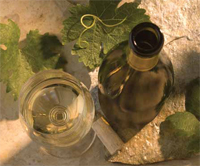The next time you’re drinking Chardonnay, ask yourself what it tastes like. If the answer is “vanilla,” it’s most likely an Australian Chardonnay aged in oak. “Peaches” means it’s a big California bruiser, while “green apples” suggests a lighter Ontario bottle. But if you think, “my Chardonnay tastes like prehistoric molluscs,” then I tip my hat to you. It means you are drinking Chablis. You lucky duck.

Chablis is a sub-region of Burgundy in France. Although Chardonnay is grown throughout Burgundy, Chablis is special. It’s the most northern district and the cool climate gives the grapes a piercing acidity. Most important, however, is the land: the best vineyards sit on soil formed during the Jurassic period from fossilized sea life. “This gives the taste of Chablis,” the winemaker Didier Séguier says. “Not of grapes. Of oysters.” These ancient shells give the wine both a delicacy and a steely bite.
Burgundy is mystifying because centuries of strict inheritance laws have subdivided the vineyards into postage stamp-sized plots, all of which produce wines that are bottled separately and classified into rigid hierarchies, under the Grand Cru designation. There are only seven Grand Cru vineyards in Chablis and Séguier’s home, Domaine William Fèvre, makes bottles from five of them, each capturing a different nuance, from spring flowers to melting beeswax.
Only a grape as expressive as Chardonnay can capture these slight differences in geography. However, this very sensitivity may now be a threat. “We have noticed global warming since 1989,” Séguier said, “It used to be a problem to reach maturity, with two good vintages in 10 years. Now every vintage we get is mature, but the new challenge is freshness.” Rising temperatures may someday make Chablis over-cooked or flabby. For now, however, it’s in a sweet spot, with ripe but elegant wine year after year. What should you drink it with? What nature intended: oysters.
Into the Short Cellar
 Domaine William Fèvre 2008 Premier Cru
Domaine William Fèvre 2008 Premier Cru
$29.95, France, Vintages #169805
A perfect harvest in Burgundy in 2008 brought just enough ripeness, keeping the acidity high, creating what Séguier calls “a vintage for purists.” This Chablis is intense and plush, with a fruity core tasting of pear and white peach. The finish sings with a long, metallic peal. 90/100
 Domaine William Fèvre 2008 Les Preuses Grand Cru
Domaine William Fèvre 2008 Les Preuses Grand Cru
$79, France, Vintages Classics Catalogue #74773
The “Les Preuses” vineyard produced my favourite bottle of the 2008 vintage. It has dense clay soil, giving the wine a tremendous aging potential. Now, it has a seamless but complex palate tasting of lime leaf, ground cherry and peapod. Stunning. 94/100
Burgundy’s Got Style
There’s more to Burgundy than Chablis. Here are the Short Cellar’s top picks of other sub-regions:
- Meursault: The district of Meursault in the Côte de Beaune region of Burgundy produces opulent Chardonnay marked by a peculiar fragrance that mixes hazelnuts, soft butter and hay.
- Pouilly- Fuissé: This is a district in the Mâconnais subregion, where many less expensive Burgundies are found. Pouilly- Fuissé offers a good balance between round pear or apple and sharp acidity.
- Puligny- Montrachet: If you regularly drink Puligny- Montrachet then give me a call, because clearly you’re a millionaire with good taste; this is a long-lived, intense wine with notes of truffle and honey.
Matthew Sullivan is a civil litigator in Toronto. He blogs once a month here on lawandstyle.ca. The Short Cellar column also appears in the print edition of Precedent. Matthew can be reached at matthew@lawandstyle.beta-site.ca. Follow along on Twitter: @shortcellar.

